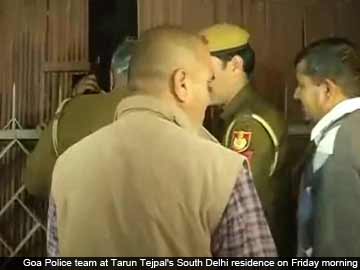Gulail, the investigative website which released tapes of purported conversations between Narendra Modi's aide Amit Shah and suspended Gujarat police officer G L Singhal to allege that the state government had subjected a young woman to illegal surveillance, on Thursday released photographs to seek to establish that the woman had known the Gujarat CM at least since 2005.
Gulail uploaded a dozen pictures of Modi's presence at the first edition of 'Kutch Sharad Utsav' in October 2005. In one of the pictures, Modi is engaged in animated conversation withIAS officer Pradeep Sharma and the woman with her face partially masked.
As per the recordings of the purported conversations between Shah and Singhal, the state police mounted an aggressive surveillance on the woman, introduced by the website as Madhuri (not her real name), in 2009 at the instance of "sahib". She was tracked in gyms, at the airport, in aircraft and even in hospital where her mother was admitted.
"These pictures raise a serious question mark about the credibility of the explanation put forth both by Madhuri's father Premlal Soni and the BJP that only Premlal was known to Modi and it was he who had requested the CM to 'take care' of his daughter in 2009 when the illegal snooping operation was mounted. The pictures show that Modi knew Madhuri for at least five years before his state machinery mounted an illegal round the clock vigil on the young woman in August 2009. It also confirms that part of the affidavit filed by Sharma in the Supreme Court in which he had alleged that Madhuri had visited Modi when he came to inaugurate the 'Sharad Utsav' in October 2005. Sharma served as the collector of Kutch district between 2003 and 2005," the website said in a statement.
The website has refrained from attesting to the veracity of the conversations.
Sharma had in May 2011 told the Supreme Court in an affidavit he had introduced Madhuri to Modi when he visited Kutch to inaugurate the hill garden project. Later, Modi and Madhuri started exchanging emails and text messages, Sharma said in his filing.
Sharma has alleged that one of the key reasons why he fell out of favour with Modi, and was later subjected to harassment, was because he was aware of Modi's proximity to the woman. Sharma moved the Supreme Court last week demanding a CBI inquiry into the illegal surveillance.
Sharma has in his application claimed that he was victimised because of his "knowledge of the intimacy shared by Shri Narendra Modi with a young lady architect, aged 27 years, from Bangalore, but originally from Bhuj in Gujarat, who was introduced to Shri Modi by the applicant himself in the year 2004".
"The said tapes/transcripts reveal a strong bias and prejudice of the state of Gujarat against the applicant herein and the state's intent to somehow implicate the applicant herein in criminal offences," the application has said.
Gulail uploaded a dozen pictures of Modi's presence at the first edition of 'Kutch Sharad Utsav' in October 2005. In one of the pictures, Modi is engaged in animated conversation withIAS officer Pradeep Sharma and the woman with her face partially masked.
As per the recordings of the purported conversations between Shah and Singhal, the state police mounted an aggressive surveillance on the woman, introduced by the website as Madhuri (not her real name), in 2009 at the instance of "sahib". She was tracked in gyms, at the airport, in aircraft and even in hospital where her mother was admitted.
"These pictures raise a serious question mark about the credibility of the explanation put forth both by Madhuri's father Premlal Soni and the BJP that only Premlal was known to Modi and it was he who had requested the CM to 'take care' of his daughter in 2009 when the illegal snooping operation was mounted. The pictures show that Modi knew Madhuri for at least five years before his state machinery mounted an illegal round the clock vigil on the young woman in August 2009. It also confirms that part of the affidavit filed by Sharma in the Supreme Court in which he had alleged that Madhuri had visited Modi when he came to inaugurate the 'Sharad Utsav' in October 2005. Sharma served as the collector of Kutch district between 2003 and 2005," the website said in a statement.
The website has refrained from attesting to the veracity of the conversations.
Sharma had in May 2011 told the Supreme Court in an affidavit he had introduced Madhuri to Modi when he visited Kutch to inaugurate the hill garden project. Later, Modi and Madhuri started exchanging emails and text messages, Sharma said in his filing.
Sharma has alleged that one of the key reasons why he fell out of favour with Modi, and was later subjected to harassment, was because he was aware of Modi's proximity to the woman. Sharma moved the Supreme Court last week demanding a CBI inquiry into the illegal surveillance.
Sharma has in his application claimed that he was victimised because of his "knowledge of the intimacy shared by Shri Narendra Modi with a young lady architect, aged 27 years, from Bangalore, but originally from Bhuj in Gujarat, who was introduced to Shri Modi by the applicant himself in the year 2004".
"The said tapes/transcripts reveal a strong bias and prejudice of the state of Gujarat against the applicant herein and the state's intent to somehow implicate the applicant herein in criminal offences," the application has said.


 Mr Tejpal, who stepped down as Tehelka's editor last week, is accused of raping a younger colleague in Goa earlier this month. The Goa Police said he would be arrested after he failed to meet a 3 pm deadline yesterday to appear for interrogation.
Mr Tejpal, who stepped down as Tehelka's editor last week, is accused of raping a younger colleague in Goa earlier this month. The Goa Police said he would be arrested after he failed to meet a 3 pm deadline yesterday to appear for interrogation.